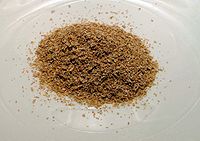
Bran
Background to the schools Wikipedia
This Wikipedia selection is available offline from SOS Children for distribution in the developing world. SOS Children works in 45 African countries; can you help a child in Africa?
Bran is the hard outer layer of grain and consists of combined aleurone and pericarp. Along with germ, it is an integral part of whole grains, and is often produced as a by-product of milling in the production of refined grains. When bran is removed from grains, they lose a portion of their nutritional value. Bran is present in and may be milled from any cereal grain, including rice, wheat, maize, oats, and millet.
Bran is particularly rich in dietary fibre, and omegas and contains significant quantitities of starch, protein, vitamins, and dietary minerals.
Bran is often used to enrich breads (notably muffins) and breakfast cereals, especially for the benefit of those wishing to increase their intake of dietary fibre. Bran may also be used for pickling ( nukazuke), as in the tsukemono of Japan.
Rice bran finds particularly many uses in Japan, where it is known as nuka (糠; ぬか). Besides using it for pickling, Japanese people also add it to the water when boiling bamboo shoots, and use it for dish washing. In Kitakyushu City, it is called Jinda and used for stewing fish, such as sardine.
Rice bran is a by-product of the rice milling process, and it contains various antioxidants that impart beneficial effects on human health. It is well known that a major rice bran fraction contains 12%-13% oil and highly unsaponifiable components (4.3%). This fraction contains tocotrienol, gamma-oryzanol, and beta-sitosterol; all these constituents may contribute to the lowering of the plasma levels of the various parameters of the lipid profile. Rice bran also contains a high level of dietary fibers (beta-glucan, pectin, and gum). In addition, it also contains 4-hydroxy-3-methoxycinnamic acid (ferulic acid), which may also be a component of the structure of non-lignified cell walls.
The high oil content of bran makes it subject to rancidification, one of the reasons that is often separated from the grain before storage or further processing. The bran itself can be heat-treated to increase its longevity.
Bran oil may be also extracted for use by itself for industrial purposes (such as in the paint industry), or as a cooking oil, such as rice bran oil.
In Romania, the fermented wheat bran is usually used when preparing sour soups, called borscht.

